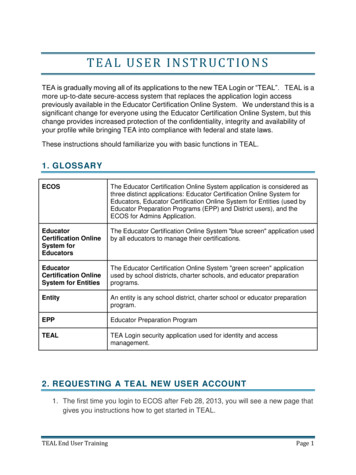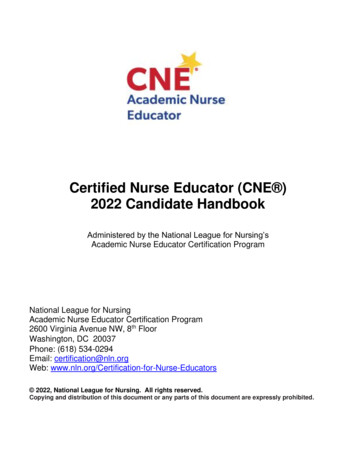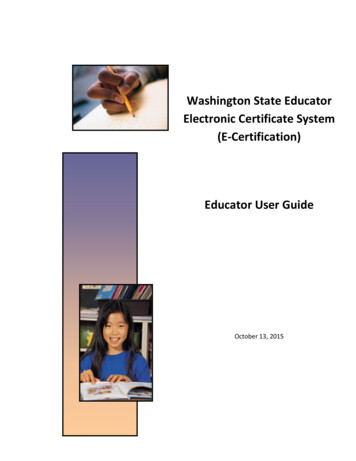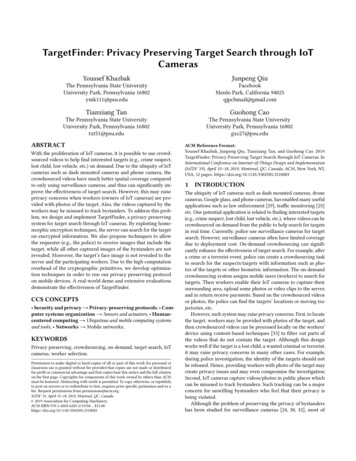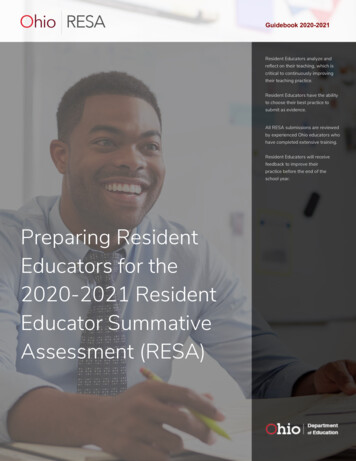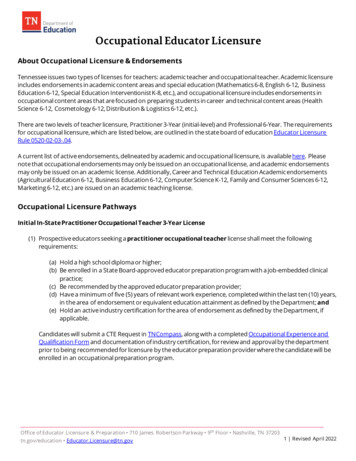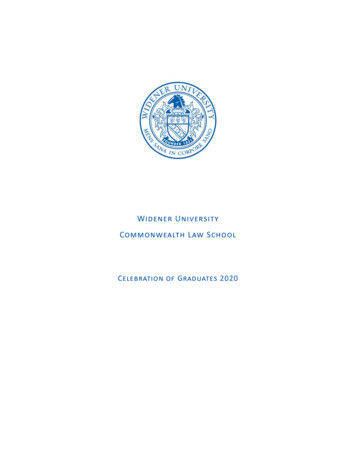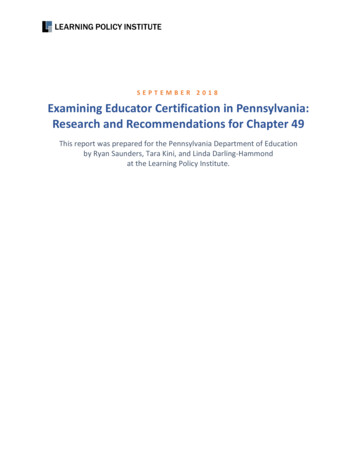
Transcription
LEARNING POLICY INSTITUTESEPTEMBER 2018Examining Educator Certification in Pennsylvania:Research and Recommendations for Chapter 49This report was prepared for the Pennsylvania Department of Educationby Ryan Saunders, Tara Kini, and Linda Darling-Hammondat the Learning Policy Institute.
Table of ContentsAcknowledgments. 3Executive Summary . 4Introduction. 6Part I: Pennsylvania’s Policy Context. 7Current Challenges in Educator Recruitment and Retention in Pennsylvania. 7The Need to Diversify Pennsylvania’s Educator Workforce. 10Pennsylvania’s ESSA State Plan. 10Review of Chapter 49 . 11Part II: Stakeholder Perspectives on Chapter 49. 12Part III: Recommendations . 16Recommendation #1: Improve Clinical Training . 17Recommendation #2: Refine Preparation Standards . 21Recommendation #3: Address Shortages . 23Recommendation #4: Revise Testing Requirements . 25Recommendation #5: Use Data to Guide Improvement . 28Recommendation #6: Support Beginning Teacher Induction. 30Conclusion . 33Appendix A: List of Stakeholder Engagement Meeting Attendees. 34Endnotes. 442LEARNING POLICY INSTITUTE EXAMINING EDUCATOR CERTIFICATION IN PENNSYLVANIA
AcknowledgmentsThe Pennsylvania Department of Education wishes to acknowledge the contributions of the 234individuals and organizations who offered their time and expertise as participants at threestakeholder meetings held in July 2018, and whose efforts were essential to developing therecommendations found in this report. A full list of attendees can be found in Appendix A.LEARNING POLICY INSTITUTE EXAMINING EDUCATOR CERTIFICATION IN PENNSYLVANIA3
Executive SummaryThe state of Pennsylvania has witnessed dramatic shifts in its teacher workforce over the pastseveral years. Enrollment in teacher preparation programs has declined nearly 65% since 2009while the number of emergency permits issued to districts unable to fill open teaching positionshas increased substantially. The percentage of teachers of color in Pennsylvania’s teacherworkforce, currently at 5.6%, lags behind the national average of 20% and falls well below thepercentage of students of color (33.1%) enrolled in the state’s public schools.The impact of these trends is felt across the state in both rural and urban districts and has long-termimplications for the state’s increasingly diverse student population. In response to these challenges,the Pennsylvania Department of Education (PDE) outlined an ambitious set of priorities in itsconsolidated plan under the Every Student Succeeds Act (ESSA) meant to strengthen the teacherworkforce. Specifically, the PDE sought to (1) tackle persistent shortages in subject areas andspecific geographic locations across the state, (2) ensure equitable access for all students to qualityteachers and school leaders, and (3) increase the diversity of the teacher workforce.Chapter 49 of the Pennsylvania CodeCoinciding with early implementation of the state’s ESSA plan, the Pennsylvania State Board ofEducation is preparing to undertake a mandatory review of Chapter 49 of the Pennsylvania Code,which establishes state requirements for preparation, certification, and continuing professionaleducation for professional personnel employed in Pennsylvania’s pre-k–12 education system.The review presents an opportunity for policymakers to work in collaboration with stakeholdersfrom across the state to strengthen the code and support improvements to the way educators areprepared to support diverse learners in the classroom.In preparing for the Chapter 49 review, the PDE convened three meetings of stakeholders in July2018. The meetings, held in Philadelphia, Harrisburg, and Pittsburgh, provided an opportunity tocollect feedback from groups invested in teacher preparation and certification regarding potentialchanges that could strengthen teacher preparation and certification and advance the state’s widerpriorities for the educator workforce. Attendees included representatives from institutions ofhigher education, district administrators, practicing teachers, parents, and advocacy groups(among others). In total, 234 stakeholders provided their feedback and insight on currentopportunities and challenges in Chapter 49.Key themes that arose in the three stakeholder meetings included 4the need to support the overall quality, improvement, and consistency of educatorpreparation across the state;the immediate challenges facing districts in staffing vacant classroom positions;the belief that improved partnerships between higher education and local pre-k–12 districtscould help support both high-quality preparation and early-career induction programs;the need to review assessment requirements for preparation and licensure and theirimpact on supporting a more diverse teacher workforce; andthe hope that available data and research would inform the eventual changes to Chapter 49.LEARNING POLICY INSTITUTE EXAMINING EDUCATOR CERTIFICATION IN PENNSYLVANIA
From the above themes and recommendations collected at the three stakeholder convenings, a setof six recommendations was developed. These recommendations are grounded both in feedbackfrom across the stakeholder meetings and in research demonstrating the potential impact andeffectiveness of such policy changes. In addition, the recommendations draw attention whereappropriate to Chapter 354 of the Pennsylvania Code, which establishes requirements foreducator preparation programs. The recommendations made in this report, while limited torevisions of Chapter 49, may require a review of Chapter 354 as the state seeks to build analigned system of teacher preparation, certification, and early-career support.Recommendations for Chapter 49Recommendation #1: Improve Clinical TrainingImprove and extend clinical training experiences.Recommendation #2: Refine Preparation StandardsRefine preparation program standards to reflect the array of teaching skills needed to fullysupport the academic, social, and emotional development of a diverse student population.Recommendation #3: Address ShortagesAddress teacher shortages in specific content areas and geographic locations in the state by creating targeted service scholarship or loan forgiveness programs to recruit individualsinto high-need subjects and locations;providing appropriate flexibility around the content requirement for special educationcandidates and expanding the special education grade span to pre-k–12; andensuring that individuals hired on emergency or substitute permits receive intensivesupport and training and are placed on an expeditious pathway to full state certification.Recommendation #4: Revise Testing RequirementsExpand methods for evaluating a candidate’s basic skills and readiness to enter a teacherpreparation program, and implement a more authentic assessment of candidates’ readiness toteach upon completion of such a program.Recommendation #5: Use Data to Guide ImprovementIncrease access to data about candidates’ and graduates’ characteristics, hiring, retention, andpreparedness to support continuous improvement.Recommendation #6: Support Beginning Teacher InductionProvide all new teachers with induction that includes mentoring, common planning time, andregularly scheduled collaboration with other teachers.In building a teacher workforce for the future, Pennsylvania faces a number of key opportunities inrevising Chapter 49. These changes have the potential to help advance a comprehensive vision forteacher preparation and early-career support that ensures all principals, teachers, and school staff areprepared to support the state’s increasingly diverse student population, and to ensure the state takesa leading role across the country in setting the standard for teacher quality and student success.LEARNING POLICY INSTITUTE EXAMINING EDUCATOR CERTIFICATION IN PENNSYLVANIA5
IntroductionIn 2016, PDE undertook an extensive stakeholder engagement effort around the development ofthe state’s Every Student Succeeds Act (ESSA) Consolidated State Plan. The effort, whichincluded convening an Educator Preparation Stakeholder Work Group, established a series ofgoals meant to guide the state into the ESSA era and through emerging educator recruitment andretention challenges across districts and schools. In its ESSA state plan, Pennsylvaniaemphasized proposals for supporting improvements across the state’s teacher and leaderpreparation systems with a focus on three major goals: (1) tackling persistent teacher shortages inspecific content areas and geographic locations, (2) ensuring equitable access to quality teachersand leaders for all students, and (3) improving the racial diversity of the teacher workforce tobetter reflect the student populations served in Pennsylvania schools.1These goals continue to guide the state as it undertakes a new phase of work: review of Chapter49 of the Pennsylvania Code, which establishes state requirements for preparation, certification,and continuing professional education for professional personnel employed in Pennsylvania’spre-k–12 education system. Essential to this review is input from key stakeholders, who bestunderstand how Chapter 49 impacts the experiences of students and educators, includingeducators-in-training. A review of Chapter 49 should also be grounded in rigorous research oneducator preparation, certification, and professional learning, including new research that hasemerged since Chapter 49 was last updated more than 10 years ago.This report proceeds in three parts. Part I provides information on Pennsylvania’s current policycontext as it pertains to Chapter 49, including current challenges with educator recruitment andretention, the need to diversify the educator workforce, and key elements of the state’s ESSAstate plan. Part II summarizes key takeaways from the stakeholder engagement that PDEconducted in July 2018 to inform the review of Chapter 49. Part III sets forth sixrecommendations for updating and strengthening Chapter 49, developed based on stakeholderinput and grounded in educational research. Where applicable, Part III notes connectionsbetween corresponding educator preparation policies housed in Chapter 354 of the PennsylvaniaCode, which establishes requirements for educator preparation programs. The recommendationsmade in this report, while limited to revisions of Chapter 49, may require a review of Chapter354 as the state seeks to build an aligned system of teacher preparation, certification, and earlycareer support.6LEARNING POLICY INSTITUTE EXAMINING EDUCATOR CERTIFICATION IN PENNSYLVANIA
Part I: Pennsylvania’s Policy ContextCurrent educator recruitment and retention challenges in Pennsylvania reflect national trends andare key elements of the policy context that should inform potential changes to Chapter 49. In thissection, we take a look at current trends in Pennsylvania’s teacher workforce, including teachersupply, demand, distribution, and diversity. We then describe key programs supporting highquality teachers and leaders currently underway in the state, as described in Pennsylvania’sESSA plan.Current Challenges in Educator Recruitment and Retention inPennsylvaniaPennsylvania faces growing recruitment and retention challenges that impact districts strugglingto fill vacant positions. In many ways, teacher workforce and labor market trends inPennsylvania mirror national trends and highlight a need to provide robust investment in theteacher workforce to help alleviate teacher shortages and high rates of turnover across the state.These trends in Pennsylvania’s teacher workforce include:A sharp decline in the number of individuals entering teacher preparation. Teacherpreparation enrollment in Pennsylvania is down 65% since 2009–10, contributing to thechallenges districts currently face in staffing classrooms with fully prepared educators.2Figure 1. Pennsylvania Teacher Preparation lmentSource: LPI analysis of Title II Reports, 2017, National Teacher Preparation Data, United States Department of Education.LEARNING POLICY INSTITUTE EXAMINING EDUCATOR CERTIFICATION IN PENNSYLVANIA7
Persistent shortages of certified educators across the state and in specific subject areas.While overall shortages in Pennsylvania are not as extreme as in some other states, shortages areheavily impacting certain geographic areas and subject areas. For the 2017–18 school year, 33 school districts across the state have been designated asgeographic areas with an inadequate supply of elementary or secondary teachers (6% ofthe state’s 500 school districts).3For the 2017–18 school year, the state designated the following subjects as shortageareas: English as a Second Language (pre-k–12), fine and performing arts (pre-k–12),foreign languages (pre-k–12), sciences (7–12), mathematics (7–12), special education(pre-k–12), and vocational education (7–12).4Sharp inequities in access to qualified teachers for students from low-income families andstudents of color. The decline in supply and the resulting shortages disproportionately impactstudents who have been historically underserved. As described in Pennsylvania’s State Plan forEnsuring Equitable Access to Excellent Educators for All Students, students in high-povertyschools and students of color are much more likely to be taught by “unqualified, not highlyqualified teachers.”5 The eight districts that top the state’s list of districts with shortages by number of unfilledvacancies are all Title I districts. Together, they reported 1,431 total vacancies this pastyear.6 While these districts served over 13% of the state’s overall student enrollment in2016–17, they served over 30% of the students of color enrolled in Pennsylvaniaschools.7Six of the eight districts designated with the greatest shortages serve primarily students ofcolor (Allentown City, Harrisburg City, Hazelton Area, Philadelphia City, PittsburghPublic, and Reading).8An increasing reliance on long-term substitute teachers serving on emergency permits9 tofill vacancies. In place of certified and fully prepared educators who support the learning of allstudents, schools across the state have increasingly had to fill vacancies with individuals whohave not yet met Pennsylvania’s educator standards nor earned a Pennsylvania teachingcertification. 8Over the past 3 years, the state has seen a 100% increase in the number of emergencypermits issued to districts and schools facing staffing shortages.10The rise of emergency permits coincides with a 71% drop in the number of newlyissued in-state Instructional I teaching certificates since 2009–10, from 15,247 to 4,412in 2016–17.11LEARNING POLICY INSTITUTE EXAMINING EDUCATOR CERTIFICATION IN PENNSYLVANIA
Figure 2. Pennsylvania Emergency Permits Issued 2014–17Emergency PermitsNumber of Permits mic YearEmergency Permits IssuedSource: Baumer, C. (2018). Pennsylvania certification of professional personnel landscape. (PowerPoint presentation).Harrisburg, PA: Pennsylvania Department of Education.Note: Emergency permits include the following types: (1) Vacant Position with an Educational Obligation to PursueCertification, (2) Long-Term Substitute with No Educational Obligation, and (3) Day-to-Day Substitute. PDE staff report thatemergency permits issued for day-to-day substitute teachers account for approximately 85% of the emergency permits issued in agiven year.High rates of teacher turnover that contribute to recurring demand for new teachers andundermine student achievement. While declining teacher supply is a concerning trend, teachershortages aren’t solely a product of insufficient supply. The demand for new teachers nationallyis driven by high rates of teachers leaving the profession or moving schools. In addition toexacerbating shortages, high rates of teacher turnover also undermine student achievement andcarry high financial costs for districts in terms of teacher replacement and onboarding.12 Currenttrends in teacher turnover reflect the state’s challenges with providing appropriate supports andincentives to keep teachers in the classrooms and subjects in which they are needed most.A look at Pennsylvania’s State Plan for Ensuring Equitable Access to Excellent Educators for AllStudents (2015) shows that turnover rates do not impact schools equally. High-poverty schools have a turnover rate that is nearly twice the rate of low-povertyschools (8% vs. 4.9%).Charter schools experience higher rates of teacher turnover compared to public schools.The turnover rate for high-poverty charter schools (21.4%) is 2.7 times the rate for highpoverty schools and is 4.4 times the rate for low-poverty schools.13 LEARNING POLICY INSTITUTE EXAMINING EDUCATOR CERTIFICATION IN PENNSYLVANIA9
The Need to Diversify Pennsylvania’s Educator WorkforceWhile Pennsylvania’s overall shortages vary across districts, student populations, and subjectareas, when considering teacher diversity, it is clear that there are far fewer teachers of color thanstudents of color in the state. By investing in increasing teacher diversity, the state and districtscan tackle at least two goals at once: addressing teacher shortages and increasing the number ofteachers of color in the workforce.The percentage of teachers of color in Pennsylvania’s teacher workforce, currently at 5.6%, lagsbehind the national average of 20% and falls well below the percentage of students of color(33.1%) enrolled in the state’s public schools.14 Increasing the number of teachers of color inPennsylvania is a high priority for the state, given the important benefits that being taught byteachers of color offers to all students, and especially to students of color. Teachers of color have been found in several studies to improve outcomes for students ofcolor, including improved academic achievement and graduation rates, increasedaspirations to attend college, fewer unexcused absences, and lower likelihoods of chronicabsenteeism and suspension.Students of color and White students report having positive perceptions of their teachersof color, including feeling cared for and academically challenged.Many teachers of color report feeling called to teach in low-income communities ofcolor, where positions are often difficult to fill. Indeed, 3 in 4 teachers of color work inthe quartile of schools serving the most students of color nationally.15 16 17In summary, Pennsylvania faces a pressing set of teacher workforce challenges: a strikingdecline in the supply of new teachers in Pennsylvania; teacher shortages that aredisproportionately impacting certain subjects, locations, and historically underserved studentpopulations; and a current teacher workforce that does not reflect the diversity of the state’spopulation. Efforts to strengthen teacher preparation in Pennsylvania must address thesechallenges, while also strengthening the ways in which teacher preparation programs prepareteachers to meet the needs of all students.Pennsylvania’s ESSA State PlanPennsylvania’s ESSA plan, approved in January 2018 by the U.S. Department of Education,highlights a number of initiatives using funds available under Title II, Part A of ESSA toimprove the recruitment, retention, support, and development of teachers and the overall racialdiversity of the state’s workforce.18 The plan proposes using funds to expand rigorous, PDEapproved clinical residency programs for teachers and school leaders through a competitivegrant program. Leveraging partnerships between districts and educator preparation programs,these programs would embed at least 1 year of clinical experience within preparation programsand would emphasize a residency model in which coursework is tightly integrated with clinicalpractice and residents commit to working in the sponsoring district upon completion of theresidency. The plan proposes giving priority consideration to communities that have reportedmultiple, chronic shortage areas. In May 2018, PDE initiated a 2 million competitive grantprogram for “Innovative Teacher and Principal Residency Programs,” implementing thiselement of Pennsylvania’s ESSA state plan in what it intends to be a multiyear competitivegrant program.1910LEARNING POLICY INSTITUTE EXAMINING EDUCATOR CERTIFICATION IN PENNSYLVANIA
Another strategy the state hopes will help address teacher shortages is a statewide Troops toTeachers program to support veterans transitioning from military service into the educatorworkforce. Funded through a 1.6 million, 5-year federal grant managed by the Defense Activityfor Nontraditional Education Support (DANTES) office, this initiative provides one or morealternative pathways to Pennsylvania certification that enable veterans who already hold at leasta bachelor’s degree to complete critical, specially designed education courses and have access toimmediate opportunities to practice that knowledge and skills as part of the pathway toPennsylvania teacher certification.20In addition to supporting the preparation of new teachers through residencies and the Troops toTeachers program, PDE is exploring the use of federal funding to encourage partnershipsbetween educator preparation programs and school districts to develop pathways into theclassroom for paraprofessionals. Furthermore, PDE is seeking to proactively promote the longterm development of a diverse and talented educator workforce through a program to provideseed grants and technical assistance to secondary schools implementing curriculum thatencourages high school students to explore teaching as a career.Review of Chapter 49Coinciding with the early stages of the state’s ESSA plan implementation and the continuedfocus on addressing growing teacher shortages, ensuring equitable access to excellent educators,and improving teacher diversity, the Pennsylvania State Board of Education is preparing toundertake a mandated 10-year major review of Chapter 49 of Section 22 of the PennsylvaniaCode.21 Chapter 49 establishes state requirements for preparation, certification, and continuingprofessional education for professional personnel employed in Pennsylvania’s pre-k–12education system. Chapter 49 regulations also overlap and connect with regulations in Chapter354 that govern educator preparation. Specifically, Chapter 354 sets forth requirements andstandards that all preparing institutions must adhere to in constructing their programs. While thisreport looks exclusively at revisions to Chapter 49, it is important to recognize that somerevisions to Chapter 354 may also need to be considered in order to advance an aligned systemof regulations that governs both educator preparation and certification in Pennsylvania.As an initial step in this process, PDE has engaged stakeholders to provide input on potentialamendments to Chapter 49. Input from different stakeholder groups across the state will guideproposals from the Secretary of Education to the State Board. Part II of this report provides asummary of key takeaways from PDE’s stakeholder engagement process.LEARNING POLICY INSTITUTE EXAMINING EDUCATOR CERTIFICATION IN PENNSYLVANIA11
Part II: Stakeholder Perspectives on Chapter 49PDE convened stakeholders at three meetings across the state in July 2018. The meetings wereheld in Philadelphia (July 24, 2018), Harrisburg (July 25, 2018), and Pittsburgh (July 26, 2018),with a total of 234 attendees representing a comprehensive cross-section of key groups investedin both teacher preparation and certification. These groups included leadership from institutionsof higher education; faculty from preparation programs; administrators from both districts andschools; pre-k–12 educators; human resources staff from districts; staff to the General Assembly;representatives from advocacy groups; and membership associations representing major schoolpersonnel groups including teachers unions, school psychologists, and early childhood educators.(See Appendix A for a full list of attendees.)Several key themes surfaced across the three meetings and are summarized below.Teacher Preparation Standards. Stakeholders presented a wide range of ideas focused onsupporting the overall quality, improvement, and consistency of preparation programs across thestate. This included a desire to see improved standards for preparation that included more“culturally responsive” and “trauma-informed” teaching practices. One districtadministrator articulated a sentiment shared across all three meetings:Going through [the] interview process and working with new teachers,[culturally responsive and trauma-informed teaching practices] is an area thatis extremely lacking. Given the increase in the diversity of students, the lackcreates many challenges. This is an immediate need; [we] must operationalizefor preparation to be specific.Assessments. Stakeholders also spent time discussing revised approaches to candidateassessment, including the value of the basic skills assessment requirement for entrance into anundergraduate program and the larger need for more authentic assessments of candidateteaching ability. While there was debate regarding the potential shape of a performanceassessment recommendation, there was overwhelming desire to see teacher candidateassessments that actually measure the types of teaching practices needed to support diverselearners in the classroom. For example, stakeholders recommended:We should be looking at what truly makes a successful teacher and looking atapplication/practice-based ways to assess and evaluate. —Charter SchoolAdministratorCreate and maintain a rigorous assessment of preservice teachers to encouragethe best teachers for our children. —Community College Instructor12LEARNING POLICY INSTITUTE EXAMINING EDUCATOR CERTIFICATION IN PENNSYLVANIA
A number of meeting participants expressed a desire to eliminate barriers to the recruitmentand retention of a more diverse teacher workforce. On top of echoing recommendations linkedto strengthening preparation standards, stakeholders also identified the basic skills assessmentas a current barrier to entrance into a teacher preparation program and area for potentialchange. The views expressed at the meetings were not necessarily about testing, but about thetype of assessment and other factors that matter more in identifying and developing qualityteacher candidates:[There should be] more options to attract more students. Testing can be ahurdle for some. —Higher Education Department ChairMore testing does not always guarantee a good-quality teacher. —PrincipalOf additional concern was the high student debt burden that teacher candidates must take on inorder to afford high-quality teacher preparation that provides them with significant clinicaltraining, and the barriers such debt posed to bringing more candidates of color into theprofession.Clinical Training. With the goal of supporting better preparation overall, stakeholders alsoexpressed a desire to see more robust clinical practice during preparation and a desire toimprove the quality and consistency of cooperating teacher support. As was highlighted by anumber of participants, cooperating teacher selection does not consistently includeconsiderations of quality or skill:Sometimes the only requirement is willingness to take a student teacher.—Higher Education Faculty MemberMentors need more support and training to lead student teachers. —DistrictAdministratorIn addition, many stakeholders voiced interest in building better connections between teacherpreparation programs and district induction programs. This included improved alignmentbetween the standards and expectations guiding these two systems:More coordination between school districts & institutions of higher education.—Higher Education Department Chair[We need] mentor programs to reduce class load in years 1 and 2 to focus onpedagogy mastery. —Union RepresentativeNot sure how this might work, but this might be the most important thing anew Chapter 49 could do for student achievement. —Higher EducationDepartment ChairLEARNING POLICY INSTITUTE EXAMINING EDUCATOR CERTIFICATION IN PENNSYLVANIA13
Stakeholders also expressed support for more flexible routes into the profession whileensuring qual
Pennsylvania mirror national trends and highlight a need to provide robust investment in the teacher workforce to help alleviate teacher shortages and high rates of turnover across the state. These trends in Pennsylvania's teacher workforce include: A sharp decline in the number of individuals entering teacher preparation. Teacher
